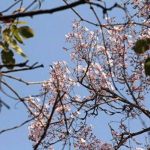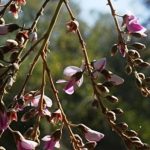TREE LIFE
DECEMBER 1995.
MASHONLAND CALENDAR
Tuesday 5th December. Botanic Garden Walk at 4.45 for 5 p.m. we will meet Tom in the public car park of the Gardens, and continue where we left off last month. There will be a guard for the cars.
Sunday 10th December. Traditionally our December outing, which is also our Christmas get-together, takes place earlier in the month. This year Vida’s charm was instrumental in getting us an invitation to Mbizi Game Park. Accordingly we are being given the use of an A-frame cottage which has a thatched and very spacious open area containing tables, a fridge (for your lunch time Christmas fare). If we are lucky and it rains we shall be assured of shelter. NB entry will be free provided the front page of Tree Life is shown at the gate; otherwise the fee will be $10 per person. We will assemble at the A-frame at 10 a.m., place goodies in the fridge and proceed to the Aloe Forest for our walk in beautiful surroundings, returning to the A-frame for lunch and a fun quiz. Braai facilities will be available.
Sunday 17th December. Dr. Anxious Masuka will be leading a fungi walk in the Mukuvisi Woodlands and Tree Society members will be welcome. Meet in the Mukuvisi car park at 2 p.m. the woodland is situated at the corner of the Mutare road and Glenara Avenue.
The date and venue for Mark’s December walk will appear in the next Tree Life.
Tuesday 2nd January 1996. Botanic Garden walk
MATABELELAND CALENDAR
Friday 1st December to Sunday 3rd December. At Kana Estates as previously advertised. Booking is now closed as all places have been taken.
Monday 11th December. The last video evening of the year. 7.45 for 8 p.m. at Girls’ College when we will show the National Geographic film on the Rainforests.
Monday 1st January 1996. Our usual social – please phone Ian or Margaret McCausland
Sunday 7th January. An all day visit to June Davies’ farm at Figtree.
Zindele Safaris – September 29 to October 1
Readers of Tree Life would have expected the Bulawayo members to be at Ikoro Safaris on the first Sunday of October as this was our advertised programme. But no such place exists. We were in fact on Oakley Block about 30km south of West Nicholson where Jack McClelland manages a 55 thousand acre ranch whose safari operation is called Zindele. His wife Jane runs a homecraft spinning and knitting industry trading under the name of Ikoro (it means hornbill). Hence the misinformation in Tree Life.
Our party arrived at the homestead at about 4-ish on Friday shortly after Tom and Anthea who had made their way down in a leisurely fashion combining game watching (elephants) and botanising.
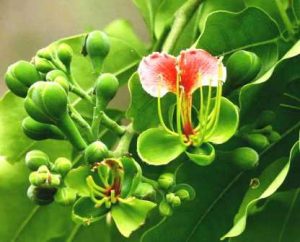
Afzelia quanzensis. Photo: Bart Wursten. Source: Flora of Zimbabwe
Matabeleland South was largely leafless except for Afzelia quanzensis, which was in the first flush of new leaf – a vivid green contrasting dramatically with the surrounding monochromes of still dormant vegetation. A vast specimen stands in the McClelland’s lush garden where we also found Berchemia discolor and Rangoon creeper Quisqualis parviflora in full bloom. It’s a wonderful subject – showy, deliciously scented and hardy. I am surprised that we do not see it more frequently in suburban gardens. A very welcome cup of tea and some excellent biscuits provided a quick pick-me-up for the last leg of our journey, a nine km ride eastwards to the banks of the Umzingwane.
The safari camp is simple and unostentatious. Perched on an outcrop of gneiss on the west bank of the river it enjoys a commanding view downstream of a most attractive sand river flanked by a riparian fringe of tall trees and lianas. Upstream the resistant band of gneiss strikes across the river breaking the channel into islands and rapids honeycombed with potholes. In camp there is a well-appointed living area and kitchen and the sleeping accommodation is found in four thatched bungalows. Hot and cold running water, flush toilets and paraffin lamps added to our comforts.
We knew it would be very hot, so planned an early start to explore the river and its environs with the intention of coming in at 10 a.m. for a late breakfast. Amazingly we managed to keep to this plan and spent a very profitable three hours working in the pleasant early morning conditions.
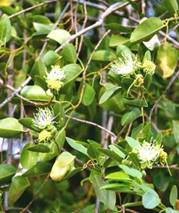
Maerua angolensis. Photo: Bart Wursten. Source: Flora of Zimbabwe
At 700 m above sea level we found ourselves on the lower edge of the middleveld and were therefore not surprised by the interesting mix of highveld and lowveld specimens. Within the riverine complex we saw Combretum imberbe, Combretum erythrophyllum, Peltophorum africanum, Diospyros mespiliformis, Lannea schweinfurthii, Acacia karroo, Maerua angolensis and Cordia grandicalyx. Added to this fairly typical highveld list were Ficus sycomorus, Faidherbia albida, Cordia ovalis and Croton megalobotrys. We saw the pattern repeated in the lianas and scandent plants. Common enough to our eyes were Acacia schweinfurthii and Artabotrys brachypetalus, but less familiar were Combretum microphyllum (looking very spectacular with its pillar box red flowers), Combretum mossambicense, Phyllanthus reticulatus (also in flower) and Tinospora caffra with its fascinating aerial roots. In the understorey we saw Maytenus heterophylla and Grewia monticola, Grewia flavescens and Grewia bicolor as well as Grewia flava. Interesting discoveries were Tacazzea apiculata and a Kanahia sp. growing in the sand of the riverbed, bright green and fresh with showy white flowers.
After breakfast we moved away from the river and headed for a distant range of hills. Acacia erubescens was everywhere in flower as was the dwarf Maerua parvifolia. We reached our destination after negotiating several precipitous gullies, commenced our climb at about noon and in memory of Noel Coward named the granite ridge Mad Dog Hill. The vegetation was very typical of the Matabeleland granite highveld and but for some majestic baobabs at the foot of the hill we could well have been in the Matopos.
The heat combined with the morning’s exertions resulted in the inevitable – a protracted siesta. In the cool of dusk we walked again in the riverine forest and returned for drinks and a convivial evening with our hosts. The next morning we made our several ways back to Bulawayo, restored by two days in the wilds of Matabeleland.
-Ian McCausland
National Botanic Gardens Fencing Project
You may now have received a pamphlet from the National Botanic Gardens regarding the massive drive for funds to erect security fencing at the Gardens. Your committee considers that the Tree Society should and must contribute and so we will establish a Fencing Fund to collect a widow’s mite to pay for at least the minimum three metres of fence costing approximately $1400. Any profits we make from selling badges and from donations etc will be channelled into the fund but we cannot do it without your help. If you would like to contribute under the Tree Society banner we would be most grateful, no matter how small.
Lyne Farm 17th October 1995
The traditional October and its effects on man and nature brought back memories of our outing to Gosho Park in October 1992, where the leafless grey mask of drought-stressed veld required some detective work. Look, sniff and touch, however, with an extra factor for us this time as we were in the Kalahari fringe soils which also contained scattered mopane, not a common sight for Harare outings.
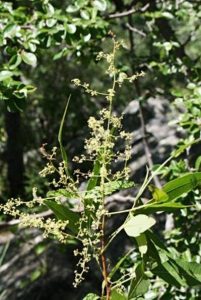
Rhus leptodictya. Photo: Mark Hyde. Source: Flora of Zimbabwe
The streams held some promise with splashes of greenery mainly Rhus leptodictya and Syzygium guineense, which had rather more cordate leaves than we expected. A spreading Schotia brachypetala occupying its favourite site on a termite mound, someone’s sharp eyes noticed the single red bud on a low branch and the Msasas decked with droopy soft green foliage being well past their coppery splendour. With the Kalahari type soils the streams often tend to flow below the sand and some scuffing with a large ‘vellie’ exposed some really damp sand but the surrounding earthworks and weirs showed just how desperate the surface water supply had become. A tumble of boulders, home to the rugged succulent Sansevieria pearsonii with its tightly ridged dark leaves and spine tips also formed a roost for a pair of raptors, possibly owls. A Boscia salicifolia, curiously misshapen also shared this prime site along with some very shrivelled Croton gratissimus, the small spherical dangling fruits providing the only key to its identity. A few small Euphorbia ingens reared their spiny ugly little heads from a crevice with the larger ones’ habitat being a row of shallow kopjies running roughly parallel with and on the opposite side of the stream. Having sampled their spines on my bare legs, the rocky outcrop was quickly spurned in favour of the flowering Albizia amara, the yellow haze of their shaving brush flowers making a delightful change from the arid surrounds. The trunks too, were very noticeable being very dark and coarsely fissured. The Gardenia volkensii were also flowering profusely, the bloom having about 9 white petals arrayed neatly around the tightly grouped yellow anthers and the yellowing mature blossoms presented an attractive patchwork of colour.
Where the soil fill had been dumped to build up the weir Rob Burrett picked up a few stone-age tools, these being ‘cores’ broken away from silcrete, a sedimentary material often found in the Kalahari fringe soils. And some casual pickings through the deep sand in the stream bed produced a few more. Here a puzzle tweaked and confused our thoughts and having recently covered Terminalia in our botanic walks I wonder what Tom Muller would have to say had he been with us! However, luck was on our side for at that precise moment the Red Arrows aerobatic team roared overhead in loose formation heading for the Air Tattoo – what an excuse! And no wonder we had a small turnout of members. Anyway, with arboreal matters pressing, we noticed the following features, typical Terminalia bark, and hardly any bark peel on the undersides with no petiole and a spike of tiny flowers on a slender stalk. The scent being like some well-worn socks, had the more active minds exploring Terminalia brachystemma, a species more familiar to our Bulawayo members. At this spot the soils seemed to become a clay and with it more leafless mopane, heavily spined Balanites aegyptiaca – simple-thorned torchwood, with its curiously paired leaves on each side of the severe green spines. Then magnificent Acacia galpinii casting welcome shadows and somewhat nearby Cadaba termitaria, which by its name suggests termite mounds and is often a spreading shrub with tiny white scales on the branches and on the small clustered leaves. Apart from a single specimen at Chedgelow and an isolated group at Darwendale, this Capparaceae is something we don’t often see on the highveld. On to something more common with Combretum hereroense just starting to flower but the fresh leaves devoid of the mouse-eared feature and a surprising find of a bottle brush Callistemon viminalis flowering happily in its naturalised home of a stream bank certainly raised the eyebrows. The spectacular sight of the day must undoubtedly be the small spreading Securidaca longipedunculata, covered in purple-violet like blossom with a sweet scent wafting about – a wonderful sight. At the other end of the scale, Zanthoxylum chalybeum appeared stark leafless and horribly spiny like some relic from Gondwanaland. Near the remains of an old homestead we found Strychnos pungens, the leaves of which have the typical 3 veins from the base and a tiny sharp spike at the tip.
This is a superb spot during summer but we didn’t realise how dry it had become and the total species count for the day of 47 wasn’t really a fair survey, and as so often happens the Vepris zambesiaca eluded us.
Many thanks to the Mumford family for letting us have a look at this most interesting area and may we have another look during the wetter months?
-Andy MacNaughtan
Botanic Garden Walk: 7th November
The topic was again the subfamily Mimosoideae of the Leguminosae.
Firstly, we looked again at the fine specimen of Dichrostachys cinerea near the car park. This species is known variously as the Chinese Lantern tree or Sickle bush. Tom clarified his remarks made last time about the subspecies and varieties described by Professor Brenan. Two subspecies are, in Tom’s view, good taxa. These are ssp. nyassana and spp. africana. Typical subspecies cinerea occurs only in Asia.
Ssp. nyassana has relatively large leaves and leaflets (some or all leaflets 2 mm or more wide) and relatively few (up to 10) pinnae, whereas ssp. africana has smaller leaves and leaflets (leaflets less than 2 mm wide) and relatively more pinnae.
Tom commented that both subspecies are widespread but ssp. nyassana more of a plateau subspecies, whereas ssp. africana occurs more in the lowveld. On next to further discussions of Albizia. Albizia brevifolia is mainly a lowveld species, occurring on the escarpment and on schist hills in the Zambezi Valley.
Albizia zimmermannii has slightly smaller leaflets than Albizia gummifera. It occurs mainly in the NE of Zimbabwe and in particular, is found at Dichwe Lemon Forest, where it occurs in an enormous grove on a hill out of the swamp. This tree can resemble Brachystegia glaucescens from a distance.
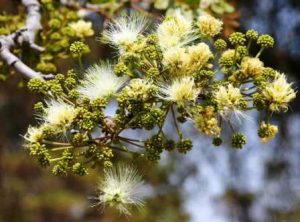
Albizia antunesiana. Photo: Bart Wursten. Source: Flora of Zimbabwe
Albizia antunesiana is the well-known common species on the highveld, although it may occur at lower altitudes. The leaflets are relatively large and discolourous (pale beneath) and often purple when young.
On Triassic sand at low altitudes in the SE of Zimbabwe occurs Albizia forbesii, a usually small tree with small leaflets. At this point, Lyn Mullin raised the interesting question of the well-known tree on Sandilboom Farm near Headlands. This has been referred to as forbesii – for example in Coates Palgrave, there is certainly a reference to an outlying population near Marandellas, presumably this record. However, Sandilboom Farm is over 1600 m in altitude, which is certainly a very different altitude from its main centre of distribution (although I imagine that this is possible). An alternative theory is that this tree is a hybrid between Albizia amara and Albizia antunesiana.
Finally, Albizia tanganyicensis is immediately recognisable by its remarkable peeling bark and smooth pale trunk.
Once again, thanks to Tom for a fascinating walk.
-Mark Hyde
Nyarupinda Catchment
October Retrospect
Birds in the garden at Tinto House.
The noise made by the participants of the dawn chorus in this Brachystegia woodland garden leads to the belief that there must be hundreds of nests in the vicinity; yet less than a dozen have been seen to breed here since we arrived in 1988. There is no doubt that keen bird watchers would have noticed many more.
The best time of the year to observe the subtle and secretive places selected for nesting is when the grass is down and the trees leafless.
On returning from holiday in early October nesting was in progress, gradually usually, but sometimes suddenly the following observations were made.
On this site the most popular tree for nest building is Julbernardia globiflora (Mnondo), these are leafy, gnarled, naturally-holed, and their wind damaged limbs provide a platform for nests. These trees have been chosen by the following species of birds: Yellow-throated Sparrow, Black Flycatcher, Masked Weaver, Striped Kingfisher, Blue Waxbill and Bennett’s Wood¬pecker. At the moment the latter are feeding their young, there have been pecking sounds inside the hole as if the chamber was being enlarged. Kurrichane Thrush fledglings in a nest atop a Mnondo stump were battered with hailstones in February this year.
A hole in a solitary Acacia nilotica (which has not re¬generated itself) was used by a pair of African Hoopoe a few years ago. This year Glossy Starlings claimed the hole by conquest. They watched whilst the pair of Hoopoe inspected the site, one went inside the hole; the other bird guarded the entrance. On subsequent visits hoopoes were bullied by starlings; there were skirmishes and lengthy chases into the woodland beyond. It is difficult to identify these Glossy Starlings; the immatures have yellow irises and blotchy brown underparts . A small colony of Masked Weavers on the outer twigs of this Acacia of the Nile are unaffected by the starlings.
A Grewia monticola near the acacia bears a Scarlet-chested Sunbird nest together with a communal wasp nest; this is the second occurrence in the garden of this association of bird and wasp. The Blue Waxbill nest and that of a wasp has been blown off Ormocarpum kirkii (caterpillar pod tree) by the recent gales. Geoff Huntly in his Veld Sketchbook Two page 152 states that Blue Waxbill deliberately seeks out the nests of wasps and build their own nests in close proximity. Another pair of Scarlet-chested Sunbird suspended their veranda-ed nest from barbed wire above the security fence, others in a Mangifera indica (mango). Blue Waxbill nests frequently come adrift from the outer foliage of trees at this time of year, but those wedged in the top of a bunch of bananas are secure. This season a pair built in a novel site amongst the paraphernalia being the centre of the satellite dish.
In an overgrown part of the vegetable garden an unseen bird, be it Prinia, warbler or Cisticola has stitched its oval-shaped see-through nest to the evergreen pinnate leaves of Nephelium litchi. This scientific name was checked in the newly acquired Reader’s Digest Oxford Complete Word-finder, what a pleasure it is to have an up-to-date dictionary! Another fruit tree Persea americana is where a Streaky-headed Canary incubated three eggs in a nest well hidden by a terminal cluster of leaves, two youngsters lived to fly away.
Outside the garden towards the Nyarupinda dam, during two consecutive breeding seasons, the extra-thick warm nests of Penduline Tits were seen in easily reached drooping foliage of Pericopsis angolensis and Pseudolachnostylis maprouneifolia. One of these remarkable nests has been saved because it is such a remarkable showpiece. Another may await discovery this season which could be as late as February.
Why no mentions of dove nests, five species frequent this place, it is because they have not attracted attention. The arrival of a sixth species, a lone male Tambourine Dove occurred in mid-October. He was walking along the arid grassy slopes near the house, the gardener let us know that he had seen a different bird and there was time to see this dove before it flew away. Full marks to Luxon for being very observant. This species was calling during the afternoon when Stan Fourie led a bird walk at Gombera Ranch near the Manyame River. The distribution map indicates that it prefers the eastern parts of Zimbabwe. The Nyarupinda riverine woodland is not comparable to that of the Manyame so it is unlikely that the Tambourine dove will visit again. Please can someone explain the name of the bird and put it in the next Tree Life newsletter.
The swallows come and go but never nest at the house; perhaps it does not provide enough shelter for them. A Black Flycatcher found a good place against the gable wall on the end of a purlin under the thatch. From year to year it is interesting to record where each bird builds its nest. The Masked Weavers are needless to say the most industrious and most annoying when they attack the trees which should provide much-needed shade in the garden.
‘Black’ Mongoose killed by the dog inside the fence
More thoughts about this strange occurrence; it was probably a rabid Water Mongoose. Reference to Mr. Reay Smithers’ book on Mammals of the sub-Saharan Region confirms the identity of this animal. There was no doubt that its habits had changed drastically. Luckily the watchdog’s rabies vaccination was up to-date.
Collecting Fungi
A very useful reference book for collectors of fungi is entitled The Larger Fungi of South Central Africa. Authors L Ryvarden, GD Pierce and AJ Masuka. The photographs are numerous and very clear, however, the binding of this book is fragile.
During our holiday in England in September the subject of edible fungi was topical because the season for collecting them in Europe is late summer and autumn.
In the September 23 edition of the Weekend Telegraph the Food and Drink page featured coloured pictures and descriptions of six kinds of edible wild mushrooms available in the shops. Oyster and shitake mushrooms can be grown on wood, others which have a symbiotic relationship with particular trees ‘are a daunting challenge for cultivation’. This article explained symbiosis in the following way, ‘the mushroom forms a sheet on the roots of the tree and its filaments deliver nutrients and water to the host, which in turn delivers sugars to the mushroom’. This is different to the text in botany books – interesting.
My apologies for the confusion which arose from ‘February is fungi month’ in Tree Life 188. If good rains come promptly fungi flush early in the hot wet season. From experience of living in this arid catchment the greatest variety of fungi is found in February.
Correction: an acacia twig with die-back bore a group of fungi which was easily overlooked because they were minute white cups. Ref. Tree Life 189 – we shall be looking for tree-rotting fungi such as this species.
Civet News
A new well-used convenience has been made by the civet in my absence. It is beside a path at the edge of a land where ground nuts have been harvested. What a thrill, another one to look at within easy walking distance.
-Benedicta Graves
The Chairman and committee members of both branches of the Tree Society wish everyone a truly peaceful and happy Christmas and a New Year wish that Zimbabwe will be blessed with some good rains.
ANDY MACNAUGHTAN CHAIRMAN


